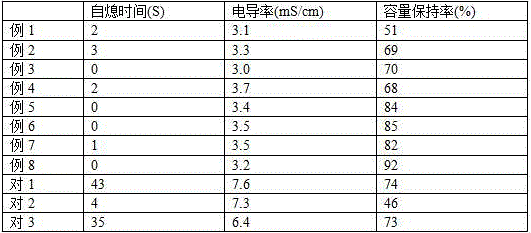Lithium battery electrolyte
An electrolyte and lithium battery technology, applied in secondary batteries, organic electrolytes, non-aqueous electrolytes, etc., can solve problems such as combustion, safety hazards, and SEI film damage, and achieve good chemical stability, good flame retardancy, and thermal stability. Highly stable effect
- Summary
- Abstract
- Description
- Claims
- Application Information
AI Technical Summary
Problems solved by technology
Method used
Image
Examples
Embodiment 1
[0038] Preparation of polyphosphorus nitrogen compounds
[0039] Weigh 10g of hexachlorotrimeric phosphazene, 0.1g of sulfamic acid, 0.08g of calcium sulfate dihydrate, and 20mL of 1-chloronaphthalene;
[0040] Set a condenser tube, drying tube, thermometer and mechanical stirring in a 500mL four-necked flask, add the above-mentioned substances into the four-necked flask, and raise the temperature to 230°C with nitrogen gas, keep the temperature for 5 hours, observe the viscosity of the material in the bottle, wait Stop the reaction when the viscosity rises obviously, if it exceeds 6 hours, stop the reaction;
[0041] Pour the above reaction solution into a 3000mL beaker containing 1200mL of heptane, stir until a white polymer precipitates out at the bottom of the cup, and separate the upper layer solution; the polymer at the bottom obtained after separation is polydichlorophosphazene.
[0042] Polydichlorophosphazene side chain substitution reaction:
[0043] Dissolve 23g o...
Embodiment 2
[0047] According to the method of Example 1, using n-pentyl p-hydroxypropyl benzoate as a substituting compound, a polyphosphorus nitrogen compound was prepared.
[0048] In an anhydrous, oxygen-free and argon-filled glove box, take 6mL of ethylene carbonate and 14mL of propylene carbonate organic mixed solution, add lithium hexafluorophosphate to the organic mixed solution to make the molar concentration 1mol / L, and finally add to the mixed solution 5% of the total mass of the electrolyte was slowly added to the polyphosphorus nitrogen compound prepared above, and the lithium-ion battery electrolyte was obtained after stirring evenly.
Embodiment 3
[0050] According to the method of Example 1, using 4-(4-hydroxybutyl)pyridine as a substituting compound, a polyphosphorus nitrogen compound was prepared.
[0051] In an anhydrous, oxygen-free and argon-filled glove box, take 6mL of ethylene carbonate and 14mL of propylene carbonate organic mixed solution, add lithium hexafluorophosphate to the organic mixed solution to make the molar concentration 1mol / L, and finally add to the mixed solution 5% of the total mass of the electrolyte was slowly added to the polyphosphorus nitrogen compound prepared above, and the lithium-ion battery electrolyte was obtained after stirring evenly.
PUM
 Login to View More
Login to View More Abstract
Description
Claims
Application Information
 Login to View More
Login to View More - R&D
- Intellectual Property
- Life Sciences
- Materials
- Tech Scout
- Unparalleled Data Quality
- Higher Quality Content
- 60% Fewer Hallucinations
Browse by: Latest US Patents, China's latest patents, Technical Efficacy Thesaurus, Application Domain, Technology Topic, Popular Technical Reports.
© 2025 PatSnap. All rights reserved.Legal|Privacy policy|Modern Slavery Act Transparency Statement|Sitemap|About US| Contact US: help@patsnap.com

